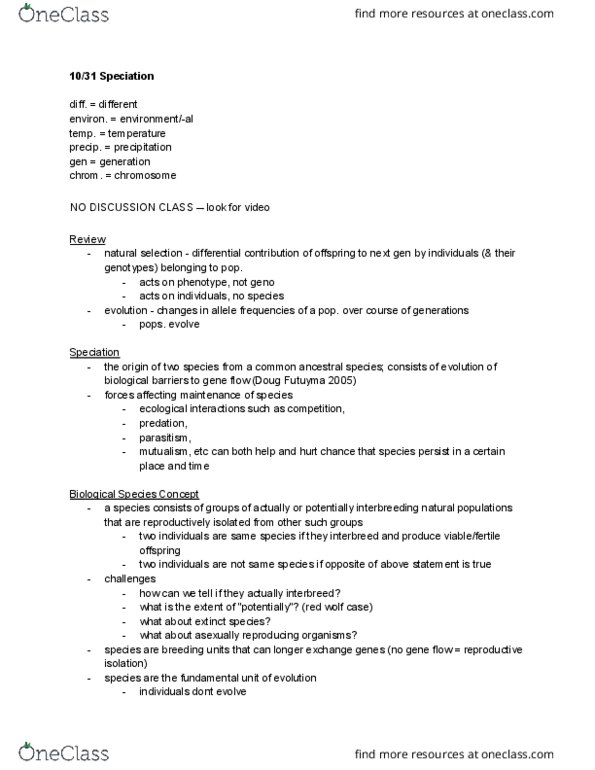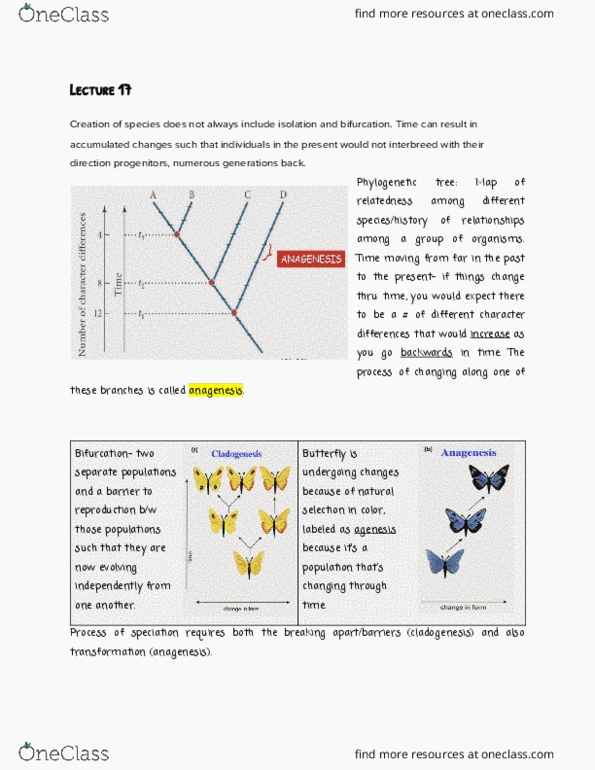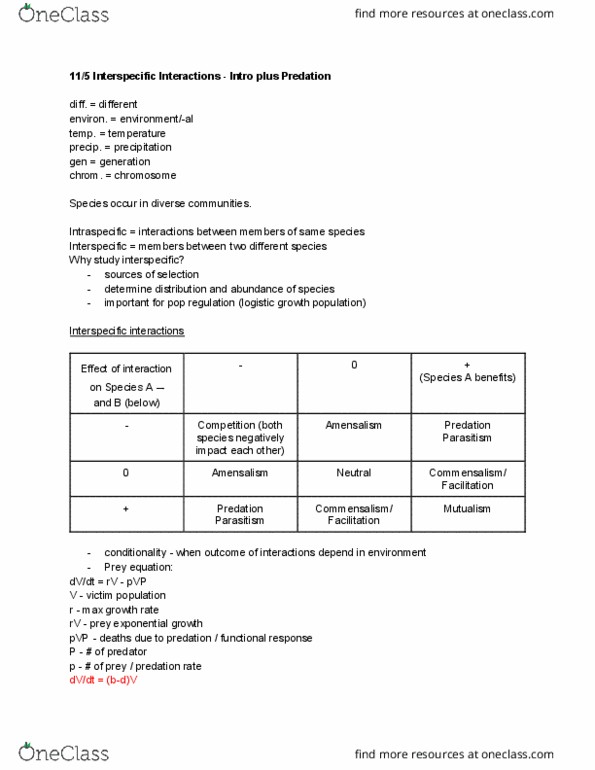As temperatures in an African savanna increase and rainfall decreases, it would most likely change into
tiaga
desert
tropical rainforest
temperate forest
What is imprinting? Give an example.
fixed assocation, such as hatching ducks recognizing the first animal they see as their mother
a learned behavior, such as a wasp circling during a search for food, so that it can return to its nest
alteration of instinct, such as a spider changing the type of web it weaves depending upon the environment
Opportunistic species
provide extensive care for their offspring
produce many offspring
reproduce later in life
What are the five agents of microevolution?
gamete production; mating; fertilization; caring for offspring; formation of herds
photosynthesis; respiration; mitosis; meiosis; fertilization
mutation; gene flow; nonrandom mating; genetic drift; natural selection
Microevolution is
new species
minor extinction of species
changes in allele frequency in a population
Which of the following is does not help defend against predators?
Toxins made by plants that injure caterpillars feeding on the plant
The large eyespots on a moth's wing that can startle a hungry bird
Thorns on a plant
Many plants have brightly colored fruit and flowers
Humans have a favored birth weight, neither too small nor too large. This is
stabilizing selection
disruptive selection
artificial selection
directional selection
What is a keystone species?
the first organism that populates an area
an organism upon which the entire ecosystem depends
the first fossils found in the earliest rock strata
As temperatures in the Arctic warm, which of the following changes may occur?
Tundra will be replaced by taiga
Taiga will be replaced by tundra
Temperate forest will be replaced by taiga
Tundra will be replaced by desert
Taiga will be replaced by temperate rain forest
What is desertification?
restoration of vegetation and water to deserts
areas adjacent to deserts also become deserts
abandonment of a habitat by animals
Evolution occurs at the level of
individuals
populations
communities
The maximum population that the environment can support is called the
biotic potential
environmental resistance
carrying capacity
replacement reproduction
demographic transition
A population with relatively more pre-reproductive individuals is common in _____-developed countries
more
less
Endangered species sometimes breed in captivity. Why are such species endangered in the wild?
Their population density is too high
Loss of habitat
Their environment is polluted
Abiotic components of an ecosystem include
only animal life
only plant life
living components only
nonliving components only
both living and nonliving components
Carbon returns to the atmosphere
as carbon dioxide
from respiration of plants
by the burning of fossil fuels
from respiration of animals
All of the answer choices are correct
Why does the Tropical Rain Forest contain an abundance of antibiotic compounds?
The area is crowded, leading to random production of useful compounds
The area is wet. plants had to develop resistance to fungi and bacterial infections
There is a great diversity of plants, leading to random production of useful compounds
The carrying capacity of the environment for a species is determined by
the reproductive rate of the organism
the number of organisms of that species
the state and national wildlife laws pertaining to that species
a complex
the limited productivity of the environment and the environmental resistance to the biotic potential of the organism
An introduced species that breeds and spreads is
resourceful
harmful
native
dominant
invasive
What is disruptive selection?
environmental influences that select against change
environmental influences that promote one phenotype versus all others
environmental influences that promote two or more phenotypes versus all others
Natural selection acts on
individuals
populations
communities
Two populations of birds live in the same area but have different sleep/wake cycles. This is
behavorial isolation
mechanical isolation
geographical isolation
temporal isolation
An insect that resembles the face of a snake avoids predation by
camouflage
warning coloration
mimicry
chemical defense
mutualism
Unselfish acts that help others in a group so that they increase their chances of surviving and reproducing is called
imprinting
mimicry
altruism
learning
instinct
If an environment changes rapidly, organisms with ____ will be more likely to survive and reproduce.
the correct allele frequency
existing neutral mutations
existing beneficial mutations
How did geology influence Darwinâs thoughts?
It demonstrated that the earth was very old, therefore there was enough time for species to evolve
it demonstrated that all continents were similar
it demonstrated the presence of many fossils
The founder effect occurs when
large groups of individuals leave their home population and establish new settlements, mating only among themselves
many members of a population die, resulting in a great loss of genetic diversity
many members of a population reproduce causing too much genetic diversity within the population
small groups of individuals leave their home population and establish new settlements, mating only among themselves.
The greenhouse effect is due to high atmospheric
Nitrogen
Ammonia
Carbon monoxide
Carbon dioxide
Oxygen
What are the Reproductive Barriers that keep species separate?
lack of food; lack of habitat; lack of potential mates; lack of nesting sites; lack of genetic variation
mountains; canyons; glaciers; bodies of water (for terrestrial animals); areas of land (for aquatic animals)
habitat isolation; temporal isolation; behavioral isolation; mechanical isolation; gamete isolation
What is directional selection?
environmental influences that select against change
environmental influences that promote one phenotype versus all others
environmental influences that promote two or more phenotypes versus all others
Which of the following is correct when describing a predator-prey cycle?
A decline in the numbers of predators causes a decline in the number of prey
A decline in the numbers of prey causes a decline in the number of predators
An increase in the number of predators triggers an increase in the number of prey
An up-and-down cycle will be seen for the prey animal
A seasonal die-off that will occur without the other species present
Why are top-level predators (lions, eagles, humans) so rare in a community?
Only a small amount of the energy is passed from one trophic level to the next
They do not breed as fast as other animals
Because of predation by higher predators
It is difficult for them to learn how to capture prey
Their job is to keep the population size of other animals in check
Alleles conferring bright color to male guppies are common because
they make males less visible to predators
they help males identify each other
they are preferred by females
Organisms that obtain their energy from producers or other consumers are
autotroph
heterotroph
producer
autotroph and producer
heterotroph and producer
What is the environmental impact of strip mining?
lack of trees exposes the surface of the earth, promoting runoff and loss of adjacent trees
removal of minerals from the soil hampers growth of vegetation
it causes a potential increase in volcanic activity
Two populations of squirrels are separated by a mountain range and would not be capable of interbreeding. This is an example of:
behavorial isolation
mechanical isolation
geographical isolation
temporal isolation
What is a danger of overfishing?
humans will become dependent upon fish
selection for smarter fish that can avoid being caught
driving the population back into the lag phase
What is meant by prezygotic versus postzygotic speciation mechanisms?
before versus after formation of a zygote
before versus after meiosis
before versus after gamete formation
The relatively short term changes in allele frequencies within a species or population is
artificial selection
microevolution.
speciation
macroevolution
Avoidance of a location with predators is the result of
imprinting
mimicry
altruism
learning
instinct
What is the difference between Density-Dependent and Density-Independent Factors on populations?
density-dependent factors exert a greater influence when there are more individuals; density-independent exerts the same influence on all individuals regardless of their number
density-dependent factors exert a greater influence on larger, more dense individuals; density-independent factors exert the same impact on individuals of all size
density-dependent factors exert the same influence on all individuals regardless of their number; density-independent factors exert a greater influence when there are more individuals regardless of their number
All of the organisms in a given location or area is termed a
peer group
flock
community
population
herd
The concentration of the pesticide DDT would be highest in
a minnow
a mosquito larva
a seagull
plankton
algae
Our biosphere is
the Earth
the atmosphere
the ocean
land on Earth
fresh and salt water
What is meant by âcarrying capacityâ?
the amount of food produced in an ecosystem
the extent of energy required to maintain an ecosystem
the number of individuals that can be supported by an ecosystem
Species living on another is
resource partitioning
coevolution
symbiosis
predation
niche sharing
One species feeding on another is
competition
a community
an ecosystem
predation
symbiosis
Populations of different species interacting with one another in a natural environment is called
competition
a community
a biome
predation
symbiosis
Which of the following is not a biogeochemical cycle?
ATP cycle
water cycle
carbon cycle
phosphorus cycle
nitrogen cycle
Horses became larger and faster to escape predators. This is
stabilizing selection
disruptive selection
artificial selection
directional selection






